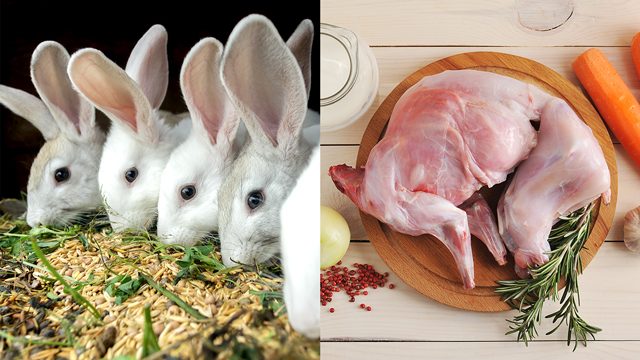SUMMARY
This is AI generated summarization, which may have errors. For context, always refer to the full article.

Rabbits are typically kept as adorable pets in the Philippines. But with prices of pork rising amid the coronavirus pandemic, should Filipinos now consider eating rabbits?
A position paper by the Department of Agricultural and Applied Economics of the University of the Philippines Los Baños said that now may be the “opportunity for the country to start exploring alternative protein sources.”
“In the short run, this will be chicken, but it should be expanded to other options (i.e. rabbit) but eventually plant-based sources of protein (i.e. soybeans and nuts).”
A kilo of pork was being sold at over P400 per kilo, prior to the government’s price ceiling.
As pork prices went up, Filipinos shifted to chicken, which then pushed chicken prices up and led the government to set a price cap on it as well.
Price ceilings, however, have been strongly opposed by hog raisers and economists, as they distort the market and create shortages.
The Department of Agriculture has long thought of rabbit meat as a potential replacement for pork. It revisited the idea again in 2020 when it became apparent that the African swine fever outbreak had yet to be contained.
In a chance interview last year, Agriculture Secretary William Dar told reporters that a rabbit’s growth cycle is very short, making it an ideal substitute.
“It’s also high in protein. Parang manok din (It’s like chicken),” Dar said in a Manila Times article.
Long way to go
There’s huge potential for rabbit meat, but farmers noted that the Philippines has a long way to go for it to be widely available and acceptable.
Chucks Dizon, a rabbit farmer in Pampanga, told Rappler that rabbit is still quite pricey, retailing at around P400 per kilo, since there are very few rabbit farmers.
“Ang rabbit industry, sa ngayon, nangangapa pa, naghahanap pa ng paraan paano mapababa ang presyo. Una, kakaunti lang ang farmers, mostly backyard. Hindi pa kaya ng maramihan at ma-meet ang demand ng ibang restaurants. Nagpaparami pa lang tayo ngayon ng raisers,” Dizon said.
(The rabbit industry is still looking for ways to lower prices. There are only a few farmers and most are raising rabbits just in their backyards. We still can’t produce enough to meet the demand of some restaurants. We’re still in the stage of looking for more raisers.)
A rabbit takes around 2 to 3 months to reach marketable size, while pigs take over double the period. Chickens are fully grown between 28 and 45 days.
But while it takes less time to raise rabbits as compared to pigs, meat quality is also another issue that needs to be addressed.
“Kailangan pa natin ng magagandang kuneho. Research pa tayo, kasi ang mga rabbit sa Pilipinas, maliliit at mabagal sila lumaki. Doon pa lang lugi na tayo, hindi na tayo puwede makipagsabayan sa ibang Southeast Asian countries,” Dizon said.
(We need better rabbits. We need to research more, because rabbits in the Philippines are small and take more time to grow. We’re already at a disadvantage considering those factors and we can’t compete with other Southeast Asian countries yet.)
For now, Dizon is still testing the rabbit industry, but he sees potential in the long term, as more restaurants in Manila have started offering rabbit on their menus.
“May humingi na restaurant, 100 kilos per week, pero hindi pa talaga kaya. Ngayon mga 20 kilos pa lang ang kaya namin,” he said.
(A restaurant asked for 100 kilos per week, but we can’t meet that yet. We can only provide around 20 kilos for now.) – Rappler.com
Add a comment
How does this make you feel?
There are no comments yet. Add your comment to start the conversation.